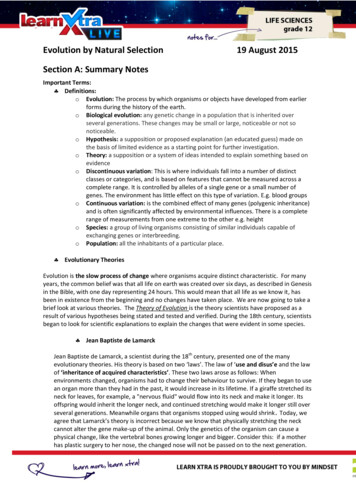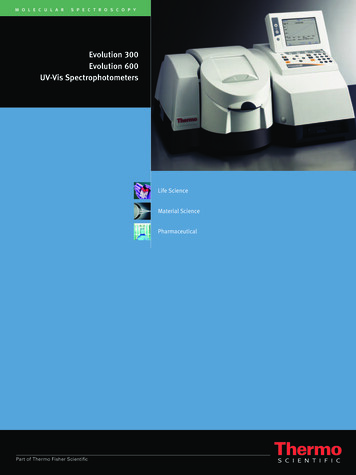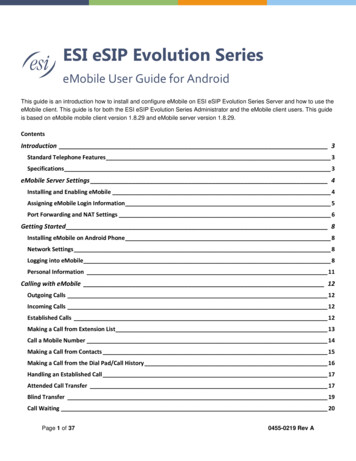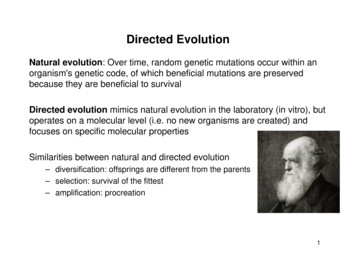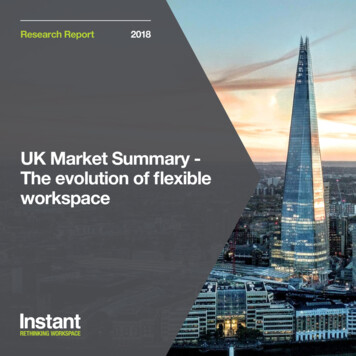
Transcription
Research Report2018UK Market Summary The evolution of flexibleworkspace
ContentsIntroduction1Workspace Supply3Flex Operators5The Flexible Product7Growth of Co-working9The “Co” in Co-working13Landlords in a Flex Market15The Managed Office18Demand for Flex Space21Why are Clients Flexing?23Spotlight on London25Growth in UK Regions31Breakdown of UK Regional Markets37UK Market Compared to the Rest of the World39The Future of Flex43The Flex Market in Post-Brexit Britain46Conclusion47
Flex Workspace in the UK:Everything is ChangingContinued growth across the UKLondon space profile changingLarger operators taking more space for corporatesEvolution of Space as a Service: the Managed OfficeFlex Space is growing in the regions, fastThe flexible workspace sector has shown dynamic growth during2017 but also increasing diversity with more operators offeringmore choice of space across more locations.*There is now a greater number of operators of flexible space thanever before, and conventional landlords have begun to enter themarket for the first time. For customers this means more choice, anumber of different options when taking up space and the inexorablegrowth of workspace as a service.Across the UK, the number of flexible office centres trackedby Instant rose to 5,320 over the past 12 months.This represented growth of just under 10% across the country –which approximately amounts to 824,000 desks across the UK –presenting companies of all sizes more choice as they increasinglyadopt flexible workspace as part of their real estate portfolio.The number of flexible workspace London centres grew by 9% lastyear with more than 1,300 flexible office locations now availableacross the capital.FLEXIBLE OFFICECENTRES ACROSS THE UK HAVEINCREASEDIN THE LAST YEARWhile this growth rate is slightly lower than we have seen inprevious years - double digit percentage growth in supply of newspace has been the norm for the past five years – there has beena change in focus for existing companies. Operators have beenlooking to increase the scale of their locations rather than thenumber of centres as customer demand profiles change and wesee more large-scale businesses looking to use this type of space.As for the question of whether the market is reaching saturation,pricing is still not being significantly discounted by the majorplayers, all of whom are seeing robust demand, and there isconfidence in the market as more companies than ever beforechoose to take flex space over conventional. It is becomingincreasingly competitive in parts of central London – such as theWest End and the City fringe – but there are many more companieswho might not have previously looked at flex space options thatare now committed to flexible workspace as part of their portfolio.JOHN DUCKWORTHMANAGING DIRECTOR UK & EMEATHE INSTANT GROUP*Full breakdown of space types on page 8.12
Workspace Supply - Market FragmentationAs supply of flex space develops across thecountry, many new players have entered themarket including those from the conventionalreal estate market.Operators such as Regus, Bizspace, WeWork andServcorp are still dominant, but strong demandfor flex options and a competitive market for: REGUS 5%: BIZSPACE 2%There are now more than 2,800 companies thathave flexible office space as part of their portfolio.This represents a 4.9% increase in the number ofoperators within the UK during 2017.As the industry matures in London we are seeing new centres openingin boroughs outside of the city centre such as Barnet and Hounslow.The increase in supply has also now reached commuter towns includingCobham, Luton and Chelmsford in 2017, which offer cost-effectivealternatives to central London hubs, and allow commuters to findlocations to work nearer to their homes.”3NUMBER OF FLEXIBLE WORKSPACES BY OPERATORconventional space have meant the long-tail of smallscale and localised providers has mushroomed.“The three largest providers of serviced office space in London in 2017only made up 17% of the total market with a huge number of nicheproviders. These smaller operators cater for unique but growing segmentsof the market such as specialist TMT space or women-only centres. As wehave seen in the US, the number of smaller operators, who run only one ortwo centres, has continued to proliferate despite the growth of the largerplayers and represent a large proportion of supply to the market.”JOHN DUCKWORTHMANAGING DIRECTOR UK & EMEATHE INSTANT GROUPWORKSPACE SUPPLY - UK WIDE: ORBITAL DEVEL 1%: FLEXSPACE 1%: WS GROUP 1%: BRUNTWOOD 1%: OTHER 88%WORKSPACE SUPPLY - LONDON WIDENUMBER OF FLEXIBLE WORKSPACES BY OPERATOR: REGUS 8%: WS GROUP 6%: LEO 3%: TOG 2%: THE BOUTIQUE 2%: WEWORK 2%: OTHER 77%4
Flex OperatorsTOTAL OPERATOR SHARE BY NUMBER OF CENTRES 2013 - 2016The market share of the top 10 operators by size is actually decreasing as amultitude of smaller players enter this dynamic and ever-shifting market.: OTHER OPERATORS: TOP 10 OPERATORS53205500499114.0%13.5%They are reported to have 2billion in leasecommitments over the next 25 years across theUK market with further expansion forecast. Evenso, the flex market is made up of a lot more thanthe largest suppliers.14.0%41383786WeWork growth has been well documented –becoming the largest occupier of commercial spacein London, other than the UK Government.According to CoStar, by the end of 2017WeWork had signed lease agreements forover 2.5million sq ft of space across London.45794500There has been a significant change over thelast year with an increasing number of operatorsdiluting the market leader’s presence. The 2016leaders, Regus, Premier and Servcorp still playan important part in the industry with Regusholding just over 5% of industry supply, but newplayers have increased the competition.14.3%The London industry in 2017 was made up of 661operators with an increase in operator numbers of7.4% being seen as a mixture of private individuals,landlords and workspace companies who continueto move into the market.15.0%35002013520142015201620176
The Flexible Product:Evolution of the Market OfferThe market for flexible workspace nowrepresents a number of different products andoptions for customers. The majority of pressattention is still garnered by the concept of“co-working” when in fact the flex marketsupply is dominated but what is best describedas serviced offices. Increasingly, landlords arelaunching their own products, offering clientsflexible solutions and the Managed Officeconcept – an outsourced office model with a 3rdparty owning the lease and operating the space –now taking up more sq ft than ever before.ADJUSTING TO MARKET DEMANDServiced offices still dominate the UK market withover 3,000 now tracked by Instant. However, the realgrowth in the market is being driven by a newer areaof the flexible office portfolio, the hybrid office thatoffers private space such as those found in servicedoffices, mixed with open, co-working spacesand flexible membership options. These caterto occupiers of all types and sizes but are mostoften associated with either start-ups or freelanceroccupiers.7What really separates these centre types is inpart design and workplace strategy but also the“curation” of the space by the operator i.e. thesense of community and atmosphere they chose toinject the space with. For many operators the skillof curation is learnt and comes with experience andknowledge of their customer base. So for many newentrants, particularly the larger, corporates who areless agile in approach, this skill is harder to come byand results in very different approaches across theUK’s centres.The supply of hybrid offices, those offering both coworking and private space, exploded in 2017 withthe tracked market more than doubling in the past12 months alone.Flexible office centres reporting ahybrid solution now make up 15% ofthe industry while those only offering atraditional serviced environment fell tobelow 65% for the first time.For what is a relatively nascent market, itdemonstrates dynamic levels of demand and amarket eager for more options from commercial realestate, which offers agility and options to occupiersof all sizes.TOTAL UK CENTRES - SPLIT BY CENTRE TYPECENTRE .7%16.4%17.5%17.7%Other7.4%7.9%8.0%8.3%8.4%TOTAL LONDON CENTRES - SPLIT BY CENTRE TYPECENTRE VICEDCO-WORKINGHYBRIDOTHERA serviced office is an office thatis fully equipped and managedby a specialist operator, whichthen rents individual offices orfloors to other companies on acost per desk basis.Co-working spaces involve a sharedenvironment, most commonly anoffice, through which individuals notengaged by the same company workside-by-side, and which is chargedon a monthly membership basis.Hybrid space refers to anamalgam of co-workingspaces and serviced officesin the same office building.Other flex space, includingoptions such as “managedoffices” etc. Flexible workspaceis the term the industry uses torefer to any type of space outsideof the conventional lease market.8
Growth of Co-workingCo-working continues to offer strong growthfor the UK flexible office industry. 2017 saw theUK industry grow by a further 12% in centrenumbers with only the US showing highercentre numbers within our global data. On aninternational scale, estimates by Small Biz Labssuggest that 1.6million people used co-workingspace globally in 2017 with approximately 14,000centres in operation. While most users do notuse co-working space daily, 70% of individualssurveyed indicated they use a space at least 3days a week.WHAT SECTORS ARE USINGCO-WORKING IN THE UK?Most sections of the business community havenow embraced this new flexible and social way ofworking, but by far the largest segment of occupiersare creative in one sense or another. If we look at thedemographics across the UK, the early growth andfocus in London and the South East matches thissegment of the UK workforce. A study conducted byNESTA indicated that over 40% of the UK’s creativelyfocused workforce was located in London and theSouth East.Over the course of the last few years thenumbers working in a creative field inthe UK have continued to expand withestimates putting the sector at just under2million jobs in 2016 and a CAGR* of 25%for the past 5 years.HYBRID VS. CO-WORKING CENTRES IN LONDONWhile not all users of co-working space are creativelyfocused there does appear to be a strong correlationbetween this workforce demographic and the growthof co-working space across the UK.268While a large proportion of co-working space usersin the UK are freelancers or companies with justone employee we are increasingly seeing enquiriesmade for centres capable of offering 3-9 desks.These companies do not necessarily want dedicatedco-working space, however they are seeking hybridenvironments that offer businesses both private officespace and a more collaborative environment.156CO-WORKINGHYBRIDWHERE IS CO-WORKING GROWINGFASTEST IN THE CAPITAL?Looking specifically at the UK’s largest co-workingcity, London, we tend to see growth of co-workingfocused centres in specific areas of the capital.Camden, Hackney and Islington all show higherthan average numbers of new centre activity.Unsurprisingly these three boroughs also see thehighest demand with enquiries spiking, particularlyin Camden.UK CENTRES BY OPERATOR TYPE: TOP 10: OTHER: INDEPENDENTS (LESS THAN 3 CENTRES)13.5%If we look at where we are seeing enquiries increase,we can gain a strong indication of future growthhotspots. One such area within London is Lambeth,which has seen enquiries for larger teams grow in thepast 6 months and is an area we will continue to trackwith interest.54%14%53%30%31%*Compound Annual Growth Rate910
The co-working model has become moreprevalent over the last 2 years, with anumber of operators offering a percentage ofdedicated space in what can be described asa ‘hybrid’ model.Co-working as a practice is what a number ofthe large operators have been keen to promote,especially with the exponential growth ofWeWork in the last 18 months.A number of global operators have offered theco-working option to clients, but the busy andoften loud environment is not suitable for manytypes of business, which does raise the questionof the sustainability and suitability of such aproduct offering.The tricky balance for the operators is makingmoney from co-working, and in general theystruggle to make as much revenue from thespace allocated to co-working as they would ifthey sold that same space as a private office.However, several operators have said it isa strong revenue stream for them, and theapproach of allocating co-working space in thebest areas of buildings close to receptions andwith lots of natural light, as this is where it helpscreate the right atmosphere.The challenge with regards to the revenuestream is that the membership turnover requiresa huge sales effort to maintain the volume ofmembers and to continue growing the clientbase.Co-working can be viewed as a flexibleworkspace solution for some individualsor companies, however it is also seen asan amenity within a building that should beoffered and is more about creating a sense ofcommunity and ambiance within a building.LUCY WATTSSENIOR DIRECTOR – STRATEGIC PROJECTSTHE INSTANT GROUPWEWORK OLD STREET COMMONS LONDON, UK1112
The ‘co’ in co-working spaces:Co-presence, Communication,Community or Collaboration?BY KERSTIN SAILER AND ROS POMEROY, BRAINYBIRDZThe co-working phenomenon is spreading fast. In addition to general growth,the sector is also diversifying. There are countless variations of co-workingspaces on offer with almost any desirable combination of location, look andfeel, size, diversity of community, workplace design, management and pricing.So how do people choose which co-working space suits them best? While usersmay decide on a variety of personal reasons (Affordable? Close to home? Wordof mouth?), there is also evidence that the opportunity ‘to connect, socialise,share knowledge and brainstorm’ is highly valued. So it is worth taking a deeperlook into what co-working spaces really can offer in this respect. We contend thatfour different social resources may be found in a co-working space: co-presence,communication, community and collaboration.Co-presence is the simple fact of occupiers working alongside each other in aco-working space. Because of the efficiency of sharing amenities, co-presence isalso one reason why occupiers join the co-working crowd. Communication arisesout of co-presence and may include chats in the lounge and kitchen areas, as wellas conversations in the corridors, or at the many networking events, that mostco-working spaces run.13Community goes beyond communication. It offers a general buzz,the appeal of background noise, also found in cafes, the atmosphereof productiveness and social chit chat; in the best case, communityoffers lasting friendships and a sense of belonging. Bill Hillier (in hisseminal book ‘Space is the Machine’) argues that community acts asa “psychological resource” in that it allows co-workers to feel part of alarger movement of like-minded individuals. Collaboration finally arisesfrom a common purpose and opportunities for different occupiers toactually work together, for example in skills swaps in entrepreneurialcontexts, or brokering new business opportunities. WeWork for instancepride themselves in the fact that 80% of their members end up doingbusiness with other members.In all of this, what is often overlooked is the role of space. Underlyingany social activity is the physical spatial setting in which it happens.Patterns of co-presence, communication, community and collaborationare therefore all products of spatial design. Physical space has thepower to bring people together, or keep them apart. It is an importantfactor, shaping the kinds of encounters one can expect to arise, as wellas the ease with which collaboration can flourish.A recent research study at UCL has found that at least twospatial factors can be shown to drive the attractiveness of aco-working space: the percentage of shared facilities, and theopportunities for occupiers to tune in and out of encounterseasily, i.e. allowing both privacy and sociality.This is an interesting and still emerging field of research, but a crucialone for suppliers of co-working spaces. As the market for co-workingbecomes more competitive, suppliers will have to develop a moresophisticated understanding of not only occupiers’ needs for copresence, communication, community and collaboration but also of therole that spatial design has in enabling them.Brainybirdz is a think-tank promoting scientific thinking in workplace design.brainybirdz.net14
Landlords in a Flex MarketLandlords have historically displayed a lack of surety aboutflexible workspace, but 2017 was the year that many changed theirapproach to the flex market. Many landlords are actively introducingflex space into their schemes or using third parties to do so.There has been a sea change in the sector with landlords radicallyrevising their view of flexible workspace as a “last resort”. Theintroduction of flex space is now seen as a key componentof place-making and creating a viable, engaging scheme.British Land introduced Storey, its own flexible workspace brand in2017. Since then a substantial number of landlords and investors haveindicated their plans to enter the market. Industry heavyweights LandSecurities and The Crown Estate have announced that they will launchtheir own flexible offer to the market in 2018. We have, of course, alreadyseen significant investment in TOG and LEO from what might be viewedas conventional players in the real estate market with multi-million poundinvestments from Blackstone and Queensgate Investments, respectively.THE FLEX SPACE MARKETIN LONDON HAS GROWN 25%IN TWO YEARS & AMOUNTS TO20MSQFTOF FLEX OPERATORS15WHAT ARE THE FACTORSCREATING THIS DEMAND?In assessing landlord interest, we can discussa variety of themes such as place-making, thegrowth of TMT companies, and interest in theWeWork model but, in short, the root cause isoccupier demand.The flex space market in London has grown 25% intwo years and now amounts to approximately 20msq ft. Flex operators – whether it is WeWork, TOG orRegus – have regularly topped the take-up charts forspace in that time.London remains the most mature flexible marketglobally with a high concentration of centres withinthe CBD alongside multiple locations in lower valueareas of the city. Despite its maturity, growth remainsstrong compared to the traditional office market witha 9% increase in centres during 2017.But what is also eye-catching for landlords is theAverage Desk Rates that are now being achievedhaving grown by more than 20% since 2014.Occupiers are seeking larger contracts, and operatorsare searching for larger spaces to meet burgeoningoccupier demand – the flexible market is beginningto encroach on the landlords’ traditional market andthey are keen to respond.Demand for 20 desk enquiries has grownsignificantly – in fact proportionatelyspeaking, they are biggest growth area ofthe market.It is this surge in demand, from corporate occupierswho might otherwise sought out conventional leases,that has made the landlord market take notice.According to the ‘2017 Deloitte London CraneSurvey’, office construction was down by 9%with only 1.8 million sq ft of new space started,the lowest volume since 2014.16
LONDON AVERAGE DESK RATE - OVER LAST YEARS: UNDER 12 MONTHS: OVER 12 MONTHS: TOTALKEY FACTORS FOR LANDLORDSCost advantages are being achieved throughlonger term contracts across the cityDESKSRates continue to increase despite more900stable market conditions in London850Terms continue to increase on average withinNEW SOLUTIONS FOR LARGER FLEX REQUIREMENTSThe rise of the managed office – a product thatis sometimes described as “space as a service”by industry commentators – has continued inthe past 12 months and provides an interestingcounterpoint to increased corporate demand forflex space.the sector as companies become more800comfortable with the flexible proposition750Slowing growth in centre numbers means we700see limited price competition compared toother markets650600Operators are starting to focus on openinglarger locations to attract medium and550enterprise sized companies who offer highervalue contracts500450400201317The Managed Office201420152016“Just as it is now easy to buy almost anySoftware as a Service, so it will become withreal estate. Space as a Service, is the futureof real estate. On demand and where you buyexactly the features, and services, you need,whenever and wherever you are.”ANTHONY SLUMBERSREAL ESTATE INDUSTRY COMMENTATORAnd deals like this are already going ahead – andproving increasingly attractive for companies ofall sizes. Instant now manages over 540,000 sqft across the UK’s 2 largest cities (London andBirmingham). The average area per managed officeis 13,000 sq ft with the offices on average cateringto teams of 140 people.Instant are not the only provider – WeWork famouslymoved into the space as a service model. IBMtook an entire WeWork space in New York for 600employees, designed and managed by WeWork.The co-working company occupies eight floorscovering around 70,000 square feet in the 10-story,86,927-square-foot building.“It’s a dedicated space just for IBM and ourclient, being at a WeWork building lets usboth get out of our own office environmentwhere there’s always a meeting, always a callto take, always someone tapping you on theshoulder with a question.”ROMAS PENCYLAVICE PRESIDENT, IBMThe Managed Office is abespoke space in companybranding that is procured andfacilitated by a third party.201718
What is driving demand for the Managed Office?WHY ARE COMPANIES LOOKINGFOR THIS TYPE OF SPACE?MARKET DEMAND FORLARGER FLEX SPACESIt is not just tech companies looking at officesmanaged in this way by a third party. Instantmanages nearly 490,000 sq ft of space withinthe UK capital with the largest office capable ofhousing 550 staff.To take a data-led view of this trend, there hasbeen year on year growth of 19% in enquiries for50 desks from corporate clients for flex space.Industry sectors using Instant managed space withinLondon include, Construction, Consulting, Finance,Transportation, Charity, Technology, Energy andPublic Services.Companies are taking up larger, branded, flexspace to help their businesses grow quicklywithout the encumbrance of additional CAPEXor having to manage the process internally.Speed of delivery for this type of flex space is acritical factor for many companies looking to scaleup our on-board project teams against tight timescales. A managed office solution can reduce timeto occupancy by three to four months for a companylooking to take on new space.Time can be saved both prior to a contract beingsigned but also post-contract, helping companiesminimise the expenditure on multiple buildingrates. In some instances, clients can be in situ inas little as six weeks compared to 7 months for acomparable, conventional lease arrangement.These firms are looking to the flex market asthey move away from conventional leases butwant more choice over brand, privacy, space andsupply over amenities than is currently availablefrom the flex operators. For instance, in a marketsuch as Birmingham where there is simply notenough flexible workspace supply to meet demand,managed offices made up 5% of total take up withinthe city in 2017.“Managed solutions take the complexityof managing an office space away from aoccupier while allowing them to have theirown private, high quality space over a flexibleperiod of time.”JOHN DUCKWORTHMANAGING DIRECTOR UK & EMEA, THE INSTANT GROUPFlexible operators are increasingly looking to securelarger floor plates to help cater for this 50 deskdemand. WeWork took on a lease of over 280,000sq ft in York Road, London last year, TOG acquired70,000 sq ft in Eccleston Square, London andRegus took on 77,000 sq ft in Great Charles Street,Birmingham at the back end of 2017, the secondlargest Regus office in the UK.INSTANT MANAGED OFFICE, LONDON EC3A1920
Demand for Flex Spacecontinues to grow and growDEMAND GROWTH 2017 VS. 2016: 50 WORKSTATIONS: 20 WORKSTATIONS19%20%To assess the industry from the demand side wecan gain insight from our own Instant enquirydata. While this data only represents a portionof the market, it does give us a picture on thechanging demand profile of potential occupiers.The UK flex market is moving more towards a hybridmodel with demand for serviced offices diminishingyear on year, as co-working and hybrid enquiriesincrease. However, serviced offices still representhalf of total UK requirements with the co-workingmodel making up less than 10%.London clearly continues to lead inoccupier demand but across the UK we areseeing higher levels of interest in marketssuch as Birmingham and Edinburgh thanever before. In a similar sense the typeof enquiry being made is also evolving aslarger companies explore flexible officespace solutions across the UK.The majority of demand still comes from companieslooking for flexible office space for 1 – 4 employeesalthough over 25% of demand now does comefrom occupiers looking for space for between 5and 25 employees. In terms of growth, head counts21between 50 and 99 are proving the real storyseeing high levels of new interest. Nowhere is thismore prevalent than London where enquiries inthis segment have grown by 19% in 2017.Corporate occupiers are making their presencefelt within the UK flexible industry. It is thoughtthat between 25% and 30% of flexible spacewithin London is occupied by corporateorganisations at present, with the proportionincreasing year on year.Demand for 20 and 50 workstationrequirements has increased by 12% and 19%respectively during the course of the year. Thisis a trend that we predict will continue goingforward with increasing demand from largeroccupier groups.IN THE LONDON AREAENQUIRIES FOR19%50-99 DESKSHAVE GROWN BY NEARLY12%15%10%5%0%20 Q1Q22017Q3Q450 FULL YEARENQUIRY INFORMATION: 1-2 PEOPLE201720160%: 3-9 PEOPLE: 10 PEOPLE49%34%17%52%32%16%25%50%22
Why are clients flexing?TERMS BELOW 12 MONTHS AND ABOVE 18 MONTHS: UNDER 12 MONTHSEnquiries for terms over a year and alsofor those looking at between 1 and 3years are increasing both in real termsand also in proportion to other termperiods. While the shortest terms,those less than 3 months, aredeclining in a general sense.If this trend continues it could be an indicationthat companies are viewing the flexible officespace sector as a long-term solution to notonly allow for flexibility but also to driveprofitability and support cultural changeswithin their businesses.The profile of companies using flexible spaceis changing. Start-ups have been commonlyassociated with the move towards theadoption of more flexible workspace but ofequal importance is the expansion into newmarkets and housing project-based teams.‘Scale ups’ are another type of organisationwho have been adopting flex space, allowinggreater agility, lower risk and more flexibilityto add additional desks when required.From a sectoral perspective, enquiries comefrom Financial, Technology, Consulting andProfessional service companies in equalmeasure with their sizes and requirementsalso highly varied.Sole traders and small companies (headcount less than 100) have traditionally madeup a large proportion of the industry butalready we are seeing large companies (headcount above 1000) making more inroads overthe last year, a trend that is likely to continue.Looking at Google Trends there isclearly a growing interest in flexible andco-working office space across the UK.Searches for “co-working” have doubledduring the year with a gradual upwardstrend month on month.201740%10%46%201651%3%0%25%50%GOOGLE SEARCHES FOR FLEXIBLE OFFICE TERMINOLOGY*1600012000800040000Qu3201423: OVER 18 MONTHS50%UNIQUE SEARCHESThe rationale for using flexible offices isalso changing with potential occupiersaccepting that flexible office space can bea long-term solution to some of their widerbusiness challenges.: 12-18 Qu42017*Search terms include Flexible Office, Co-working Space, Co-working, Shared Office Space, Shared Office, Serviced Office24
25%OF CENTRESOVERSpotlight on London:Growth in the CapitalIN LONDON OFFERHYBRIDLondon remains the focal point of the UK’s flexibleoffice industry with over 25% of the tracked centresoperating within the greater London area, but thismarket is starting to mature.Growth has slowed at a total level, with increases incentral London centres falling below the proportionalgrowth in supply elsewhere in the UK. However, the sizeand shape of centres in London are changing, as theyreach the next stage in their development.The average size of flexible offices is increasing, and themarket definitely has a greater number of large centreswithin the Capital.WORK SPACEIN 2017 THE AVERAGEDESK IN LONDONCOST OVER 690A number of operators are now taking on spacesabove 100,000 sq ft, which is far above the averageflexible space within the London market.We are also increasingly seeing centres focus on providinghybrid space with the look and feel of a co-working centrebut with far more private office space available thanhotdesking open plan environments.AFTER SEVERAL YEARS OF HIGH ACTIVITYCAMDEN &SOUTHWARKGENERATEDSIGNIFICANT INTERESTFOR FLEXIBLE OFFICE SPACE2526
Supply of Space in LondonHybrid centres – those combining co-workingand serviced office space - are bucking theoverall London trend and showed growth withinLondon through 2017. Over 25% of centresbased in London now offer hybrid work space,the largest percentage wi
adopt flexible workspace as part of their real estate portfolio. The number of flexible workspace London centres grew by 9% last year with more than 1,300 flexible office locations now available across the capital. Across the UK, the number of flexible office centres tracked by Instant rose to 5,320 over the past 12 months.




